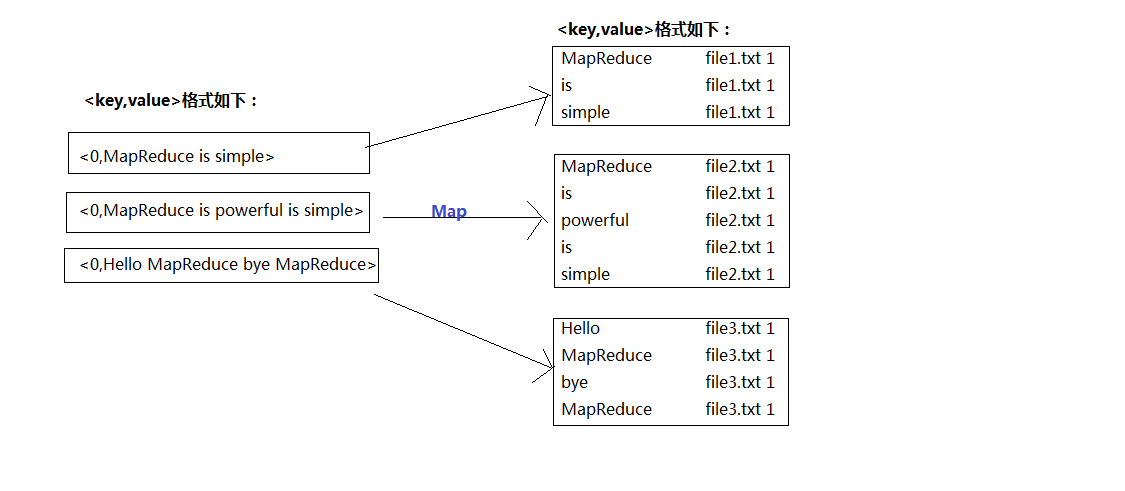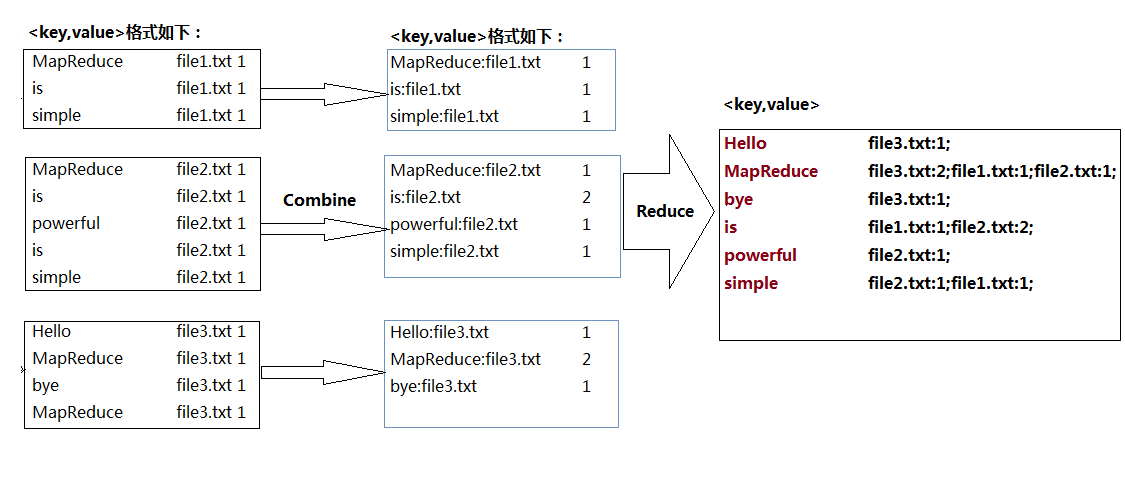Hadoop之倒排索引
2024-10-19 17:44:55
前言:
从IT跨度到DT,如今的数据每天都在海量的增长。面对如此巨大的数据,如何能让搜索引擎更好的工作呢?本文作为Hadoop系列的第二篇,将介绍分布式情况下搜索引擎的基础实现,即“倒排索引”。
1.问题描述
将所有不同文件里面的关键词进行存储,并实现快速检索。下面假设有3个文件的数据如下:
file1.txt:MapReduce is simple
file2.txt:mapReduce is powerful is simple
file3.txt:Hello MapReduce bye MapReduce
最终应生成如下索引结果:
Hello file3.txt:
MapReduce file3.txt:;file2.txt:;file1.txt:
bye file3.txt:
is file2.txt:;file1.txt:
powerful file2.txt:
simple file2.txt:;file1.txt:
--------------------------------------------------------
2.设计
首先,我们对读入的数据利用Map操作进行预处理,如图1:

对比之前的单词计数(WorldCount.java),要实现倒排索引单靠Map和Reduce操作明显无法完成,因此中间我们加入'Combine',即合并操作;具体如图2:
--------------------------------------------------------------
3.代码实现
package pro; import java.io.IOException;
import java.util.StringTokenizer;
import org.apache.hadoop.conf.Configuration;
import org.apache.hadoop.fs.Path;
import org.apache.hadoop.io.IntWritable;
import org.apache.hadoop.io.Text;
import org.apache.hadoop.mapreduce.Job;
import org.apache.hadoop.mapreduce.Mapper;
import org.apache.hadoop.mapreduce.Reducer;
import org.apache.hadoop.mapreduce.lib.input.FileInputFormat;
import org.apache.hadoop.mapreduce.lib.input.FileSplit;
import org.apache.hadoop.mapreduce.lib.output.FileOutputFormat;
import org.apache.hadoop.util.GenericOptionsParser; public class InvertedIndex {
final static String INPUT_PATH = "hdfs://hadoop0:9000/index_in";
final static String OUTPUT_PATH = "hdfs://hadoop0:9000/index_out"; public static class Map extends Mapper<Object, Text, Text, Text> { private Text keyInfo = new Text(); // 存储单词和URL组合
private Text valueInfo = new Text(); // 存储词频
private FileSplit split; // 存储Split对象 // 实现map函数
public void map(Object key, Text value, Context context)
throws IOException, InterruptedException {
// 获得<key,value>对所属的FileSplit对象
split = (FileSplit) context.getInputSplit();
StringTokenizer itr = new StringTokenizer(value.toString());
while (itr.hasMoreTokens()) { // 只获取文件的名称。
int splitIndex = split.getPath().toString().indexOf("file");
keyInfo.set(itr.nextToken() + ":"
+ split.getPath().toString().substring(splitIndex));
// 词频初始化为1
valueInfo.set("1");
context.write(keyInfo, valueInfo);
}
}
} public static class Combine extends Reducer<Text, Text, Text, Text> {
private Text info = new Text(); // 实现reduce函数
public void reduce(Text key, Iterable<Text> values, Context context)
throws IOException, InterruptedException {
// 统计词频
int sum = 0;
for (Text value : values) {
sum += Integer.parseInt(value.toString());
} int splitIndex = key.toString().indexOf(":");
// 重新设置value值由URL和词频组成
info.set(key.toString().substring(splitIndex + 1) + ":" + sum);
// 重新设置key值为单词
key.set(key.toString().substring(0, splitIndex));
context.write(key, info);
}
} public static class Reduce extends Reducer<Text, Text, Text, Text> {
private Text result = new Text(); // 实现reduce函数
public void reduce(Text key, Iterable<Text> values, Context context)
throws IOException, InterruptedException {
// 生成文档列表
String fileList = new String();
for (Text value : values) {
fileList += value.toString() + ";";
}
result.set(fileList); context.write(key, result);
}
} public static void main(String[] args) throws Exception { Configuration conf = new Configuration(); Job job = new Job(conf, "Inverted Index");
job.setJarByClass(InvertedIndex.class); // 设置Map、Combine和Reduce处理类
job.setMapperClass(Map.class);
job.setCombinerClass(Combine.class);
job.setReducerClass(Reduce.class); // 设置Map输出类型
job.setMapOutputKeyClass(Text.class);
job.setMapOutputValueClass(Text.class); // 设置Reduce输出类型
job.setOutputKeyClass(Text.class);
job.setOutputValueClass(Text.class); // 设置输入和输出目录
FileInputFormat.addInputPath(job, new Path(INPUT_PATH));
FileOutputFormat.setOutputPath(job, new Path(OUTPUT_PATH));
System.exit(job.waitForCompletion(true) ? 0 : 1);
}
}
4.测试结果
Hello file3.txt:1;
MapReduce file3.txt:2;file1.txt:1;file2.txt:1;
bye file3.txt:1;
is file1.txt:1;file2.txt:2;
powerful file2.txt:1;
simple file2.txt:1;file1.txt:1;
Reference:
[1]Hadoop权威指南【A】Tom Wbite
[2]深入云计算·Hadoop应用开发实战详解【A】万川梅 谢正兰
--------------
结语:
从上面的Map---> Combine ----> Reduce操作过程中,我们可以体会到“倒排索引”的过程其实也就是不断组合并拆分字符串的过程,而这也就是Hadoop中MapReduce并行计算的体现。在现今的大部分企业当中,Hadoop主要应用之一就是针对日志进行处理,所以想进军大数据领域的朋友,对于Hadoop的Map/Reduce实现原理可以通过更多的实战操作加深理解。本文仅仅只是牛刀小试,对于Hadoop的深层应用本人也正在慢慢摸索~~
最新文章
- ecstore-lnmp环境下crontab不执行原因
- css-让div永远在最底部
- poj 2945 trie树统计字符串出现次数
- Java设计模式 之 命令模式
- tensorflow2
- httpwebrequest 请求压缩,接受压缩的字符流请求
- .Net码农学Android---前言
- hdu 1423
- 三角形div的原理
- ibatis resultMap 结果集映射
- webpack基础入门
- css3基础知识——回顾
- JavaScript高级程序设计---学习笔记(三)
- (cljs/run-at (JSVM. :browser) "简单类型可不简单啊~")
- ImCash:第一个集多功能于一身的数字资产平台
- centos6.0和7.4默认网卡配置
- ionic3打包不能prod的问题
- python:逻辑运算与编码
- 树状数组训练题2:SuperBrother打鼹鼠(vijos1512)
- css中元素的位置